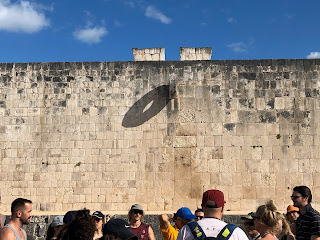Cenote Ik-Kil is located at a close distance to the Mayan ruins of Chichen Itza, on the highway to Valladolid.
It is arguably one of the most beautiful cenotes of Mexico.
In order to reach the water you have to climb down 26 meters.
The water is 40 meters deep while its diameter is 60 meters.
Compared to other cenotes found in Mexico, Ik Kil has many facilities for visitors including a restaurant on site and even cottages where one can spend a few relaxing days.
The waters of Ik Kil were considered sacred by the Mayans who performed here human sacrificing to their rain god.
Bones and jewelries were found in the deep waters of this cenote by archaeologists and speleologists.
Valladolid is a popular city in which to explore the history and culture of the Yucatan peninsula. From colonial era churches and architecture to natural attractions like cenote, notable sights include the colonial era cathedral Ex-convent and church Convent of San Bernardino de Siena named after saint Bernardino of Siena which was built by Franciscan missionaries between 1552 and 1560 in the Sisal neighbourhood. In downtown Valladolid is the cathedral of San Servacio located in the main square of the city. The center of the city's grid-like road structure features a plaza surrounded by restaurants and shops.
Chichen Itza
Chichen Itza[nb 1] was a large pre-Columbian city built by the Maya people of the Terminal Classic period. The archaeological site is located in Tinúm Municipality, Yucatán State, Mexico.[1]
Chichen Itza was a major focal point in the Northern Maya Lowlands from the Late Classic (c. AD 600–900) through the Terminal Classic (c. AD 800–900) and into the early portion of the Postclassic period (c. AD 900–1200). The site exhibits a multitude of architectural styles, reminiscent of styles seen in central Mexico and of the Puuc and Chenes styles of the Northern Maya lowlands. The presence of central Mexican styles was once thought to have been representative of direct migration or even conquest from central Mexico, but most contemporary interpretations view the presence of these non-Maya styles more as the result of cultural diffusion.
Chichen Itza was one of the largest Maya cities and it was likely to have been one of the mythical great cities, or Tollans, referred to in later Mesoamerican literature.[2] The city may have had the most diverse population in the Maya world, a factor that could have contributed to the variety of architectural styles at the site.[3]
The ruins of Chichen Itza are federal property, and the site's stewardship is maintained by Mexico's Instituto Nacional de Antropología e Historia (National Institute of Anthropology and History). The land under the monuments had been privately owned until 29 March 2010, when it was purchased by the state of Yucatán.[nb 2]
Chichen Itza is one of the most visited archaeological sites in Mexico with over 2.6 million tourists in 2017.[4]
 Temple of Kukulcán (El Castillo) dominates the center of the archaeological site | |
Location within Mesoamerica | |
| Location | Yucatán, Mexico |
|---|---|
| Region | Yucatán |
| Coordinates | 20°40′59″N 88°34′7″WCoordinates: 20°40′59″N 88°34′7″W |
| History | |
| Periods | Late Classic to Early Postclassic |
| Cultures | Maya civilization |
| Official name | Pre-Hispanic City of Chichen-Itza |
| Type | Cultural |
| Criteria | i, ii, iii |
| Designated | 1988 (12th session) |
| Reference no. | 483 |
| State Party | Mexico |
| Region | Latin America and the Caribbean |






































0 comments:
Post a Comment